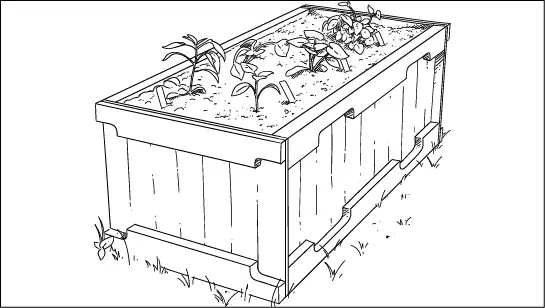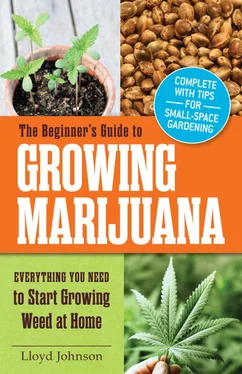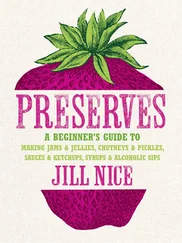The containers you decide to use will depend on your budget and your ingenuity; growers are continually finding new sources for earth-containing cannabis homes. There is no right way or wrong way, as long as you remember drainage is a key factor with containers.

Raised wooden garden bed.
A container-grown plant is far more dependent on you for food than a plant that grows in the ground. Even if they are fed on schedule, the ground-planted cannabis can seek out nutrients. The container plant has a much smaller and rigidly limited environment; they react much more quickly if you forget or delay a feeding.
Once your little seedlings are up, they are working hard at building healthy roots and making large green leaves for efficient photosynthesizing. Photosynthesis is the process your plants use to combine sunlight, water, and carbon dioxide to produce oxygen and sugar (energy). Your soil mix must provide enough food for the plants to work with.
The right soil mix is essential to produce large, green, and happy plants. Cannabis is a fast grower and big feeder. It is much more sensible to plan ahead and not wait until the plant is frantically signaling you that it needs food or that its drainage is poor.
If you are working with clones, put the plants in their final containers right away. If you are starting from seed and must deal with the sexual differentiation phase, you will not have the space, time, money, or inclination to put each little seedling into a big grow container. Until they declare male or female, you will be monitoring them in three- to five-gallon containers and feeding them frequently. If you are growing indoors, a three- to five-gallon container may be the largest your plants will get. Indoor growers have limited space and do not necessarily want the garden to outgrow its room.
Consider the Soil
The basic requirement for all cannabis is nutrient-rich, well-drained soil. If you are not a gardener already, you may want to start out using really good, bagged potting soil. Some gardeners mix their own because they have control over ingredients and amendments. And, of course, there is the question of cost. There are various kinds available at garden centers, but do not be swayed by price alone. A cheap mix will be heavy on the perlite (not that perlite is bad—in fact, it is very good for drainage—but it contains no nutrients at all).
It is also important to note that many potting mixes are made to support an average-size houseplant in a small pot. They are frequently manufactured entirely from wood and bark fiber, composts, and soil conditioners, with a light, fluffy texture. This texture requires the addition of sandy loam to make cannabis happy. Additionally, these mixes seldom contain enough nutrients to support healthy cannabis growth for more than a few months, if even that long.
Starter Mixes
A good starter mix is one-third sandy loam for drainage, one-third compost you have made, and one-third organic bagged soil. If your grow is small, or cost is no object, a mix of the FoxFarm Ocean Forest Potting Soil is really the way to go. If you plan to mix soil, sandy loam can be purchased in bulk at some garden centers and by the yard at rural feed and fuels.
You should screen all your soil through a compost screen; this will remove lumps and bits of wood or other compost components that have not broken down.
The discard materials can be thrown back on your compost pile or used for mulch around other garden plants. Once you have screened your components, the soil will be easy to mix. It is easiest to screen and mix by the wheelbarrow load; the wheelbarrow makes a convenient mixing bowl and you can make certain all components are blended before filling your containers. Wear gloves and a mask while you screen and mix, especially if the materials are dry enough to be dusty.
Money Smart
You can easily make a compost screener by using pieces of two-by-four board and some strong, metal screening. Make a square the size that will fit over a wheelbarrow and nail the screening to one side of the square. The wooden frame will make a lip to hold soil as you rub it through the screen into your wheelbarrow.
Water in the Soil
Once you have filled your containers with the carefully blended, screened soil mix, you need to gently water the soil and mix lightly to eliminate dry spots. Fill the container to standing water three times; note the water coming from the drain holes. This should ensure that the soil mix is evenly dampened.
Plant Your Seedlings
Prepare a hole slightly deeper than the pot the seedling currently sits in, scratch in a small handful of bone meal, unpot, and gently place the seedling in the hole. It is better to transplant when the seedling’s soil is slightly dry; soil that is wet can break apart and take some of the seedling’s root system with it. Fill in around the seedling and gently but firmly press it into the soil; this will make for good soil contact for the roots and helps the plant transition more easily. Water the seedling and gently press it in place one more time. Ideally, transplanting should be done in early morning or in the evening so seedlings are not shocked by the hot noontime sun.
If you start out with pure high-end bagged soil or create a similar blend on your own, there is really no need to initially feed too much extra if the containers are large. A small handful of bone meal worked into the planting hole will start each young plant off with good root-building food, and the plant will draw what it needs from the soil.
A manure tea can be fed once a week after watering; manure teas are so gentle that some growers feed each time they water. If your plants have a healthy green foliage and are growing vigorously, they are getting what they need. Stay alert for narrowing of leaves or yellowing in color; the plants are signaling they need food. Bear in mind that indicas tend to have very dark green leaves, and sativas are a paler green, like healthy bamboo. Do not mistake a genetic trait for a plant problem. Plants that are hungry for nitrogen will pale; feed with manure tea and observe them. If you were correct, the plants should respond within three to four days.
Figure on using about a gallon of composted manure to four gallons of water to brew manure teas. Some kinds of manure are higher in nitrogen than others (bat guano is one of the highest), so you can adjust your blend slightly as you see how your plants respond.
If you use packaged fertilizers or ones you need to mix before applying, remember to use only organics, and know that more is not better. Read and follow instructions carefully to prevent burning your plants.
Remember, rooftops or decks can be much windier than gardens closer to the ground; wind dries out plants and soil, so these sites will require more and closer moisture monitoring. Also, plan ahead and bear in mind that large containers of soil can get extremely heavy when fully watered, either by you or by rain. Make certain your deck or rooftop can safely take the weight of your container garden.
The amount and how you water in container gardening will have a large effect on how well your cannabis plants grow. Cannabis likes to dry out a little bit between waterings—the soil should just be starting to pull away from the rim of the containers. Then you need to water slowly with a gentle stream from your hose. The goal is to have the water gradually permeate the soil mix all over, not to create channels of least resistance where water runs down and out.
Читать дальше













